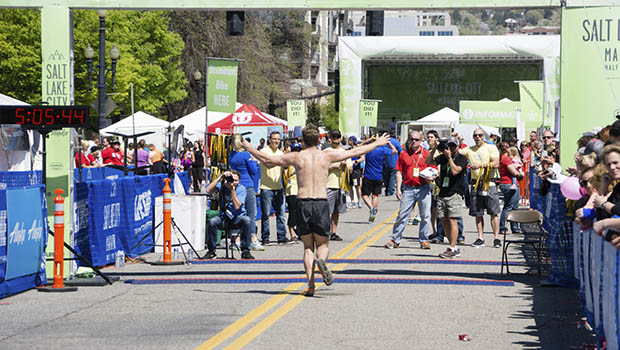
By clicking on the product links in this article, we may receive a commission fee at no cost to you, the reader. Sponsorships and affiliate commissions help support our research so we can help you find the best products. Read the full affiliate disclosure here.
Running a marathon is an undertaking that, in this coach's opinion, should not be taken lightly. Whether your goal is simply to finish well with a view toward future marathons, or to chase a significant personal best and qualify for Boston, preparing for this event requires planning and vision.
This article will discuss a long-term approach toward a marathon build-up. This process is targeted at two types of runners:
- Those who have been removed from the sport due to injury or a prolonged rest period of six months or more (i.e. an honest self-assessment reveals that you're out of shape)
- Those who are relatively new to the sport and have been running for less than a year.
These types of runners will need to adapt this or a similar long-term approach toward running a successful marathon.
As a side note, I believe a marathon is not the best target event for new runners. I am fully aware that "bucket-listers" occupy a place in our sport; however, creating long-term passion for long-distance running is tougher when so many are targeting the longest and most brutal running event as their first-ever race goals. Can folks with little running experience "finish" a marathon with eight, 10 or 12 weeks of training? Certainly. But why not take 5 to 6 months and do it better, regardless of your goals? If you are not deterred by my shot across the proverbial running bow, then let's continue.
Make marathon training even easier with THIS TREADMILL from Nordictrack:
First 1 to 3 Months
If you are beginning your marathon training program already in poor or less-than-ideal shape, then your "introductory phase" of aerobic development should be an extended period of at least 10 to 12 weeks. In fact, for runners at this level of fitness, this opening period cannot be overdone. The more time runners spend on healthy aerobic development, the better because this ramp-up period is, in the words of the late British coach Harry Wilson, the "training-to-train period" of a build-up. Training to race can and will come later.Below is a sample build-up week. This period focuses on weeks of gradual adaptation.
Sample Week 1 to 6
- Sunday: Run easy for 45 to 50 minutes. This run should be a very controlled time-on-your-feet (i.e. conversational pace) effort. Following the run, add an additional 35 to 40 minutes of brisk walking, or another form of non-running exercise (swimming, stationary biking, elliptical)
- Monday: rest day (no running); optional cross-training, such as swimming or pool running
- Tuesday: Run easy for 35 to 40 at a conversational pace.
- Wednesday: Run for 30 minutes with an additional 30 to 35 minutes of cross-training.
- Thursday: off; complete rest
- Friday: Run easy for 35 to 40 at a conversational pace.
- Saturday: cross-train day; complete 45 to 55 minutes of swimming, cycling or walking
As you can see in this introductory period, there's no true long run, and cross-training supplements the running you complete during this time. While not running specific, exercise such as swimming, stationary bike spinning and even walking will make the transition to higher volume training—necessary for a quality marathon experience—more seamless.
MORE: Four Valuable Marathon Lessons
Sample Weeks 7 to 12
- Sunday: Run for 70 to 90 minutes (run should last for 90 minutes by weeks 10, 11 and 12) easy with moderate 1-minute pick-ups every 6 minutes over the last hour. Return to a comfortable training rhythm between each surge. Pick-ups should be assertive but only so fast. Conclude run with 6 x 100m strides for economy. Practice consuming fluids and energy (calories, preferably carbohydrates) during your long runs. Take 6 to 8 ounces of fluid every 30 to 35 minutes, and ideally 100 to 120 calories of energy intake within the same period.
- Monday: rest day (no running); optional aerobic cross-training such as swimming or stationary biking for 55 to 65 minutes
- Tuesday: Run easy for 45 minutes with 8 x 100m strides to finish run.
- Wednesday: Run easy for 15 to 18 minutes followed by 6 to 7 x 2-minute moderate pick-ups, each with 2 to 3 easy jogging between intervals. Cool down for 10 minutes (roughly a one-hour workout).
- Thursday: rest day; no running or optional cross-training
- Friday: Run easy for 45 minutes with 8 x 100m strides to finish run.
- Saturday: cross-train for 60 to 70 minutes
Note the less-than-gradual ramp-up in terms of the overall volume of work as well as the amount of non-running exercise. In addition the first "harder" workout was added to allow your body to begin working on the early elements of anaerobic threshold development. One must train "uncomfortably" at times to see breakthroughs.
Sample Weeks 13 to 19 (7-Week Transitional Block)
After three months of "training to train" comes the period of marathon adaptation. In other words, the first 12-week period was designed simply to prepare you intelligently for what is to come. Assuming you have completed the above first three months, it's time to begin preparing legitimately for your marathon.- Sunday: Run for 1 hour and 45 minutes to 2 hours and 25 minutes with 2 to 3 "pushes" within the run at or a hair harder than marathon effort (I recommend a 3-mile push followed by a 2-mile push with 15 to 20 minutes easy between the pushes over the final hour of the run). This long run should be abbreviated by 20 percent every third week in this period
- Monday: rest day (no running); cross-training optional
- Tuesday: Run for 50 to 55 minutes at a conversational pace.
- Wednesday: Warm up for 15 to 20 minutes, then run 3 miles at roughly 15 to 20 seconds per-mile slower than your current 10K race fitness. After this opening piece, jog slowly for 5 minutes to recover, then run 6 x 4-minute pick-ups at the same pace or a touch quicker than the opening 3-mile block. Jog easy or walk for 3 minutes to recover between each pick-up. Cool down for 15 to 25 minutes
- Thursday: Run for 30 to 40 minutes followed by 45 minutes of cross-training.
- Friday: Run for 60 minutes with the final 30 minutes run at a moderate pace.
- Saturday: cross-train
Week 19 is a planned down week in which the long run should be largely non-existent.
MORE: The Importance of Base Building for Marathon Training
Weeks 20 to 25 (6 Weeks of Marathon Specificity)
This is the meat of the schedule. This six-week block will not only prepare you physiologically to handle race day, but also enable you to finish the race well and have a positive marathon experience.- Sunday: Run for 2 hours and 40 minutes to 3 hours and 30 minutes during weeks 20 and 23. This run should be relaxed in nature with a simple 1-minute surge largely at conversational pace. In the afternoon that same day, complete 30 minutes of a relaxed stationary bike spin or swim session. During weeks 21 and 24, reduce the volume of this long run by 15 percent. During week 25, there's no long run
- Monday: rest day (no running); cross-training optional for 70 to 80 minutes
- Tuesday: Run easy for 60 to 65 minutes with 8 x 100m strides to finish.
- Wednesday: Warm up with 18 to 20 minutes of controlled running, then complete 6 to 8 x 100m.
- Thursday: Run 3 to 4 miles, cross-train, or take a rest day.
- Friday: Run 8 to 6 miles "as you feel." Finish with 10 x 200m accelerations on the track or on a flat bike path stretch. These 200s should be run at roughly 5K pace with 200-meter slow walk/jog between them.
- Saturday: you-choose easy day—either run easy or cross-train
I highly recommend using a longer race such as a 10-miler, half marathon or even a 25K (15.5 miles) one or two times in lieu of the longer run during this six weeks. Even if your marathon goal is simply a solid healthy finish, you will undoubtedly enjoy the experience more (and be more accustomed to racing) by having one or two race "situations" leading in to your marquee event.
Week 26: The Taper
Tapering for a marathon is the least scientific element to the event. Some athletes prefer a longer 2 1/2- to 3-week taper, and others prefer a shorter taper. I'd suggest a week-and-a-half taper for those following this marathon training plan.The penultimate week of training should have a reduction of volume between 15 to 20 percent with an additional 20- to 30-percent reduction on the final week into race day. During the final week of training, there's no long run.
- Sunday: Run controlled for 65 to 70. Finish with 8 x 100m accelerations.
- Monday: rest day
- Tuesday: Run relaxed for 35 minutes.
- Wednesday: Warm up for 15 minutes, then run for 30 minutes at marathon effort. Cool down for 15 minutes.
- Thursday: Run relaxed for 35 minutes.
- Friday: rest day
- Saturday: Run easy for 20 minutes with 6 x 100m strides to finish.
- Sunday: race
There are a few key differences between the crash-course build-up, the traditional build-up and this long-term approach. In this plan, time rather than distance is used as the metric for this build-up. The reasons for this vary; however, with new marathon runners, or ones who have taken a significant break, using time rather than distance takes the pressure off of weekly mileage expectations, and allows runners to train by feel rather than hypothetical numbers.
This long-term approach may appear to be quite the commitment, but know that preparing properly for the marathon will allow you to start the race with greater confidence, and reduce the likelihood of you being a "one-and-done" marathoner.
READ THIS NEXT: What Happens When You Run a Marathon Without Proper Training?
About the Author

Get ACTIVE on the Go


Couch to 5K®
The best way to get new runners off the couch and across the finish line of their first 5K.
Available for iOS | Android








Discuss This Article